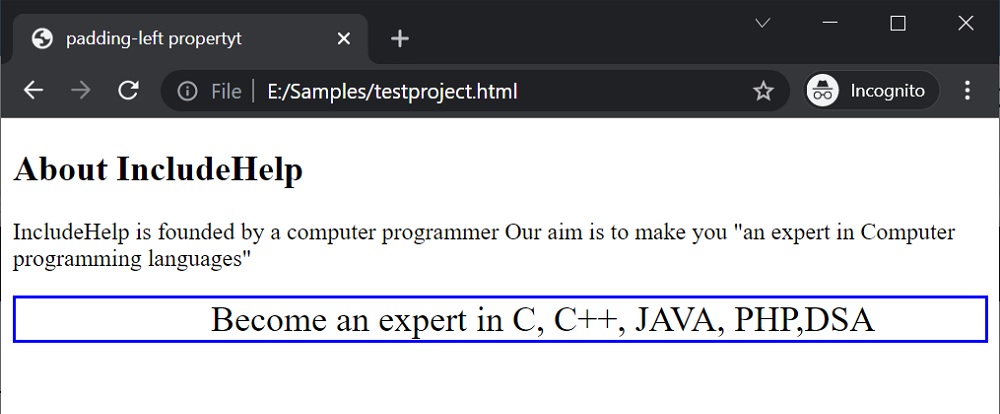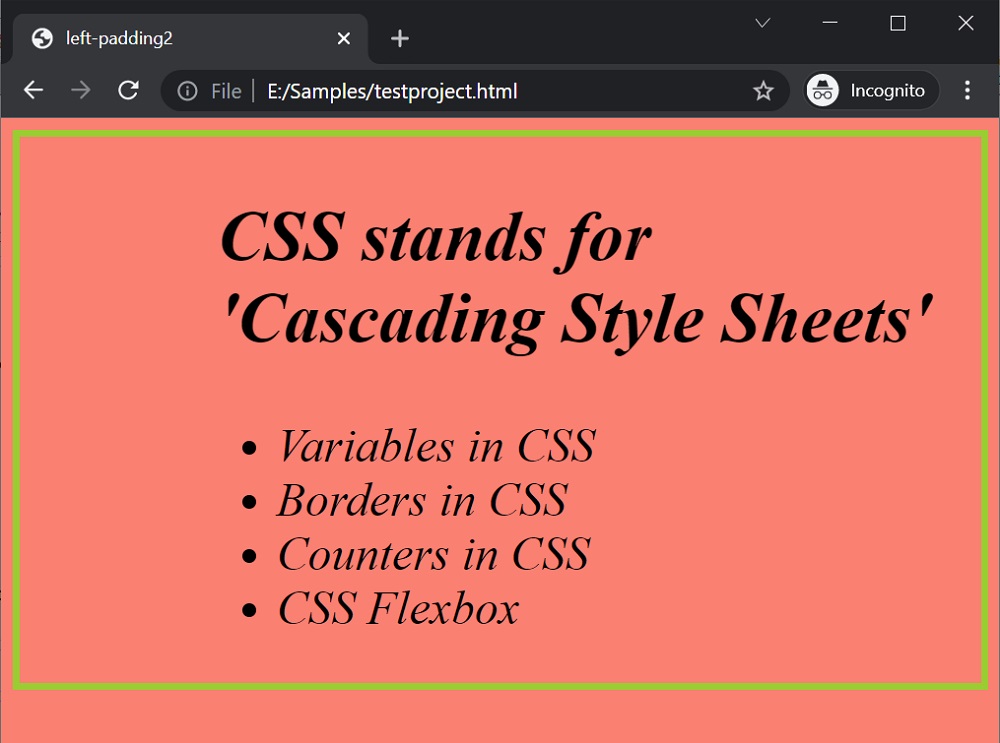Home »
CSS
CSS padding-left Property
Learn about the CSS padding-left Property, its usages, syntax and examples.
Submitted by Shahnail Khan, on March 06, 2022
Padding in CSS is one of the most important properties in customizing web pages. It provides spacing between the element's content and its circumscribed border. The padding is a shorthand property of padding-top, padding-left, padding-right, padding-bottom. In this article, we will learn about the padding-left property with examples.
Let's understand this property in detail.
What is padding-left Property?
The padding-left property is used to give padding (space) from the left side. The default value is 0.
Syntax:
padding-left: %| length| initial| inherit
Quick overview of the syntax used,
| Value |
Explanation |
| % |
left padding in terms of percentage of the width of a class |
| length |
left padding in terms of units of length (cm, m, px, pt., etc.) |
| initial |
padding-left property to its default value |
| inherit |
same padding-left property as used in container (parent) class |
The examples given below illustrates the use of padding-left property
Example 1:
<!DOCTYPE html>
<html lang="en">
<head>
<meta charset="UTF-8">
<meta http-equiv="X-UA-Compatible" content="IE=edge">
<meta name="viewport" content="width=device-width, initial-scale=1.0">
<title>padding-left propertyt</title>
</head>
<style>
.content {
font-size: x-large;
border: 2px solid blue;
padding-left: 20%;
}
</style>
<body>
<h2>About IncludeHelp</h2>
<p>IncludeHelp is founded by a computer programmer
Our aim is to make you "an expert in Computer programming languages"
</p>
<div class="content">
Become an expert in C, C++, JAVA, PHP,DSA
</div>
</body>
</html>
Output:

We have set the padding-left property to 20% only to the content class. Therefore, the text inside this class is shifted towards the right, creating some space to the left.
Example 2:
<!DOCTYPE html>
<html lang="en">
<head>
<meta charset="UTF-8">
<meta http-equiv="X-UA-Compatible" content="IE=edge">
<meta name="viewport" content="width=device-width, initial-scale=1.0">
<title>left-padding2</title>
</head>
<style>
body {
border: 5px solid yellowgreen;
background-color: salmon;
padding-left: 100pt;
font-style: italic;
font-size: xx-large;
}
</style>
<body>
<h2>CSS stands for 'Cascading Style Sheets'</h2>
<ul>
<li>Variables in CSS</li>
<li>Borders in CSS</li>
<li> Counters in CSS</li>
<li>CSS Flexbox</li>
</ul>
</body>
</html>
Output:

As you can see in this code, the padding-left property targets all the elements inside the body. We have set padding-left to 100pt. All the elements inside the body shift towards the right by 100 pt., creating some space towards the left.
CSS Tutorial & Examples »
Advertisement
Advertisement